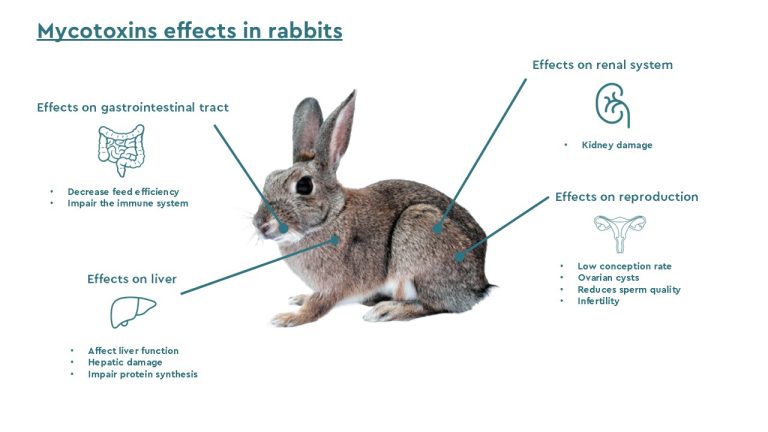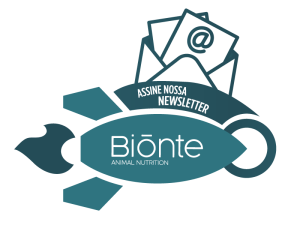Safety of raw materials and feeds for different animal species represents one of the biggest challenges in the animal production sector in recent decades. Among the most persistent problems is mycotoxin contamination, which affects animal production and management systems (Jedziniak et al., 2019). Although different species show different degrees of susceptibility to these compounds, generally the consumption of a contaminated diet can induce acute and chronic effects, including teratogenic, carcinogenic, estrogenic or immunosuppressive effects.
In rabbits, mycotoxicosis is characterized by reduced feed intake and, therefore, negativily affects in feed conversion rate, reduced average daily gain and reproductive capacity, and increased disease incidence (due to immunosuppression) (Said et al., 2022).
The European Union has set limits (2006/576/EC) for several mycotoxins in complete feedingstuffs. However, these limits only apply to certain cases and, especially in rabbits, more research is still needed to establish the side effects of these toxins.
In vivo studies have shown that rabbits are the most susceptible species to aflatoxins (AFs), with an average lethal dose of 300 mg/kg of body weight. Compared to other animal species, they range from 0.55 to 17.9 mg/kg of body weight (Mezes, 2008).
The most common symptoms documented in aflatoxicosis are loss of appetite, diarrhoea, depression, less weight gain and high mortality (Figure 1; Hassan et al., 2014). Furthermore, Meissonnier et al (2008) observed that AFs cause bile duct proliferation, fatty liver and suppression of the immune response. On the other hand, it has also been described that aflatoxin B1 may act as a predisposing factor for mucoid enteritis, facilitating the proliferation of microorganisms and the disruption of the intestinal barrier (Mogollon et al., 1981).
The reported effects of ochratoxin A (OTA) include teratogenic effects, skeletal abnormalities, soft tissue abnormalities and kidney damage at a dose of 0.1 mg/kg (Figure 1; Mezes, 2008).
Concerning deoxynivalenol (DON), its pathogenic effects in humans as well as in other species are well documented. In rabbits, although it is well known that the intestinal tract represents its main target organ, information on the effects of DON is limited.
In a study in weaned rabbits, contamination of feed with DON (1.5 mg/kg bw) caused a decrease in average daily gain, impairment of intestinal morphology and change in the distribution and expression of inflammatory cytokines (Yang et al., 2019).
Regarding T-2 toxin, the lethal dose in rabbits is 1.1 mg/kg bw, indicating its high sensitivity (Morcia et al., 2016).
In addition, it has been reported that rabbits intoxicated with T-2 toxin may experience inhibition of hepatic protein synthesis (Meloche and Smith, 1995), leading to extended liver damage. On the other hand, both T-2 toxin and its metabolites can also reduce spermiogenesis (Fenske and Fink- Gremmels, 1990). Moreover, a marked increase in liver weight has been observed in rabbits after 4 weeks of T-2 toxin administration (Szabó et al., 2014).
In rabbits, zearalenone ( ZEN) – induced intoxications are characterised by specific symptoms such as low conception rate, low fertility, vaginitis and vaginal secretion (Čonková et al., 2001). Additionally, in males, ZEN impairs spermatogenesis and decreases libido (Fenske and Fink-Gremmels, 1990).
Similarly to other species, fumonisins (FBs) inhibit sphingolipid biosynthesis through inhibition of the enzyme sphingosine N-acetyltransferase (Wang et al., 1991; Astoreca et al., 2013). Studies have confirmed the nephrotoxic and hepatotoxic effects of FB1 in rabbits (Gumprecht et al., 1995), as well as its detrimental effects on haematopoietic organs (Mariscal-Quintanar et al., 1997). In addition, rabbits exposed to FBs have been observed to show lethargy, loss of appetite and reduced urine production (Szabó et al., 2014).

Figure 1. Effects of mycotoxins in rabbits.
Conclusions
In summary, mycotoxin contamination represents a significant challenge for food safety and animal welfare in rabbit farming. Despite the implementation of regulations in an attempt to reduce the exposure, more research is still needed to fully understand the side effects of mycotoxins in this species. Management of mycotoxin contamination is not only crucial to protect the health of rabbits, but also to ensure the safety and quality of products for human consumption.



